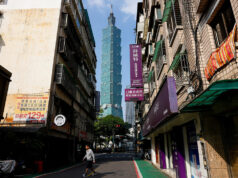Alice Reyes on 50 years — and counting — of Ballet Philippines
TRAVELING AROUND the world and representing the Philippines as a diplomat was the plan. However, fate decided that Alice Reyes would spend her professional life dedicated to the art of movement. “I was going to be in foreign service,” the 2014 National Artist for Dance told BusinessWorld in an interview in November. After all, she had a Bachelor of Arts degree in History and Foreign Services from Maryknoll College and completed post-graduate studies in Ateneo De Manila University.
The arts, however, had always been part of her life. “I come from a musical family,” she explained.
Her mother, Adoracion Garcia-Reyes, was a coloratura soprano and voice teacher, while her father, Ricardo Reyes. He was known as “Mr. Philippine Folk Dancer.” Her younger sisters, Denisa and Edna Vida, are also dancer-choreographers, while Cecille is a pianist.
“I was dancing all the time with my father,” Ms. Reyes said. At a young age, she and father joined the Bayanihan Philippine Dance Company (now the Bayanihan Philippine National Folk Dance Company). “I was exposed to the theater on Broadway, in London, and Paris.”
It was after completing her post-graduate studies in international relations that she deepened her education in dance at a workshop at the Center of Dance in Colorado Springs.
“I was very fortunate to study with [American choreographer] Hanya Holm,” she said. “And that was the opening to my realization that I should probably just accept the fact that my life is going to be in dance.”
Instead of pursuing a career as a diplomat, Ms. Reyes dedicated her life to rehearsing and working with choreographers, performing classical ballet and Filipino dances.
In 1969, Ms. Reyes, with the support of Eddie Elejar, founded the professional classical and contemporary dance company Ballet Philippines (BP) where she served as artistic director for 20 years from 1969 to 1989. BP was also the first resident company of the Cultural Center of the Philippines (CCP).
THE CREATIVE PROJECT
On Nov. 27, the newly opened CCP Black Box Theater was dim and quiet after Ms. Reyes had finished having her picture taken signing copies of her new book.
Edited by Elizabeth V. Reyes, and designed by Dopy Doplon, the cover of the coffeetable book — titled Alice Reyes & Ballet Philippines: A 50-Year Legacy in Dance — shows a black and white photograph from a scene in one of the company’s early shows, Seasons of Light. BusinessWorld sat with the National Artist at the front row of the theater, while the guests had cocktails at the lobby after the program.
“When I became National Artist, NCCA (National Commission for Culture and the Arts) has this program where they give [you] funds for a creative work,” she said. She decided to work on a book in 2017, the same year she returned to Ballet Philippines as artistic director again.
According to Ms. Reyes, since she “was not, at that time, in a position to do a new choreography,” she took inspiration from Nic Tiongson’s coffeetable book about National Artist for Theater and Design Salvador Bernal.
Published under ABS-CBN Books, Ms. Reyes’ book is divided into two sections — Legacy and Repertoire.
The “Legacy” section features seven essays about Ms. Reyes’ personal history, the early years of the dance company, and the company’s trajectory for dance in the country, young choreographers, and dance education.
The essays are written by Beatrice Homann, Nestor Jardin, Elizabeth V. Reyes, Doreen G. Yu, Edna Vida, Richard Upton, and Gina Katigbak-Garcia.
The “Repertoire” section features 45 of BP’s best dance works over the last 50 years. Two-hundred-and-fifty black and white photos were chosen from over 2,500 photos and digital files from the BP dance archives. The photos are taken by renowned dance photographers including Rudy Vidad, Jaime Zobel, Victor Ursabia, and Jojo Mamangun.
“[The book] is basically the story of how important it is for Filipinos to stay and work here, create, perform, develop things, because we are such a talented group of people,” Ms. Reyes said. “We were very fortunate to be able to collaborate. And with that, we, through all the 50 years, have developed pieces, works, dances, that speak of the Filipino soul, and Filipino stories.
“It also shows the range of what we can do as artists,” she added, citing classical works by Bach and Tchaikovsky. “[It shows that] we can do all these styles and that dance can be a career,” she added.
Since its founding, Ballet Philippines has staged over 500 choreographic works such as Amada (1969), Tales of the Manuvu (1977), and Rama Hari (1980). The dance company has also performed internationally in countries such as Canada, the USA, Australia, the United Kingdom, Japan, China, Greece, Germany, Portugal, and Switzerland.
TAKING IT FURTHER
Since her comeback as artistic director, Ms. Reyes has stepped away from creating new choreography to give way to younger choreographers.
“Instead of making new works, I encourage the younger people to choreograph, and to make their statements, to make their contributions to the world of dance,” she said.
BP’s upcoming projects include a commissioned work choreographed by award-winning, Hong Kong-based Filipino choreographer and BP alumni Carlo Pacis in celebration of the 500th anniversary of the world’s first circumnavigation, as well as a US tour in October 2020. “We’re continuing to make new dances from the younger choreographers, and planning the 52nd [season]. And so, it goes on,” she said.
Alice Reyes & Ballet Philippines: A 50-Year Legacy in Dance will be available soon in leading bookstores. For updates, follow @abscbnpr on Facebook, Twitter, and Instagram or visit www.abs-cbn.com/newsroom. — Michelle Anne P. Soliman



